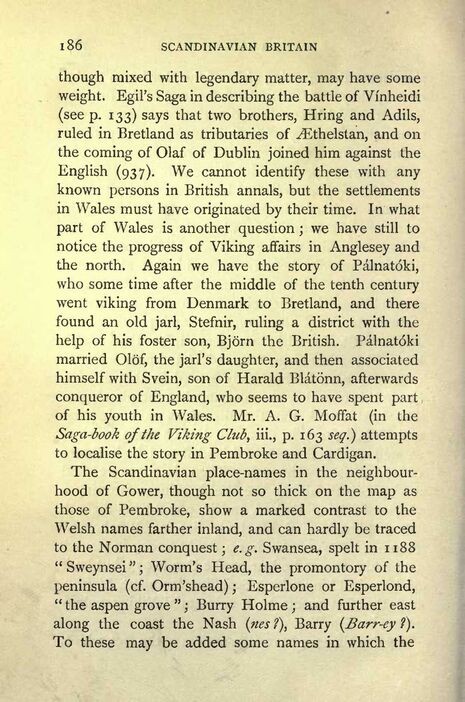
Full resolution (JPEG) - On this page / på denna sida - Scandinavian Britain - III. The Norse Settlements - 1. Wales

<< prev. page << föreg. sida << >> nästa sida >> next page >>
Below is the raw OCR text
from the above scanned image.
Do you see an error? Proofread the page now!
Här nedan syns maskintolkade texten från faksimilbilden ovan.
Ser du något fel? Korrekturläs sidan nu!
This page has been proofread at least once.
(diff)
(history)
Denna sida har korrekturlästs minst en gång.
(skillnad)
(historik)
though mixed with legendary matter, may have some
weight. Egil’s Saga in describing the battle of Vínheidi
(see p. 133) says that two brothers, Hring and Adils,
ruled in Bretland as tributaries of Æthelstan, and on
the coming of Olaf of Dublin joined him against the
English (937). We cannot identify these with any
known persons in British annals, but the settlements
in Wales must have originated by their time. In what
part of Wales is another question;
we have still to
notice the progress of Viking affairs in Anglesey and
the north. Again we have the story of Pálnatóki,
who some time after the middle of the tenth century
went viking from Denmark to Bretland, and there
found an old jarl, Stefnir, ruling a district with the
help of his foster son, Björn the British. Pálnatóki
married Olöf, the jarl’s daughter, and then associated
himself with Svein, son of Harald Blátönn, afterwards
conqueror of England, who seems to have spent part
of his youth in Wales. Mr. A. G. Moffat (in the
Saga-book ofthe Viking Club, iii., p. 163 seq.) attempts
to localise the story in Pembroke and Cardigan.
The Scandinavian place-names in the neighbourhood of Gower, though not so thick on the map as
those of Pembroke, show a marked contrast to the
Welsh names farther inland, and can hardly be traced
to the Norman conquest; e.g. Swansea, spelt in 1188
"Sweynsei";
Worm’s Head, the promontory of the
peninsula (cf. Orm’shead ; Esperlone or Esperlond,
"the aspen grove"; Burry Holme;
and further east
along the coast the Nash (nes?), Barry (Barr-ey?).
To these may be added some names in which the
<< prev. page << föreg. sida << >> nästa sida >> next page >>